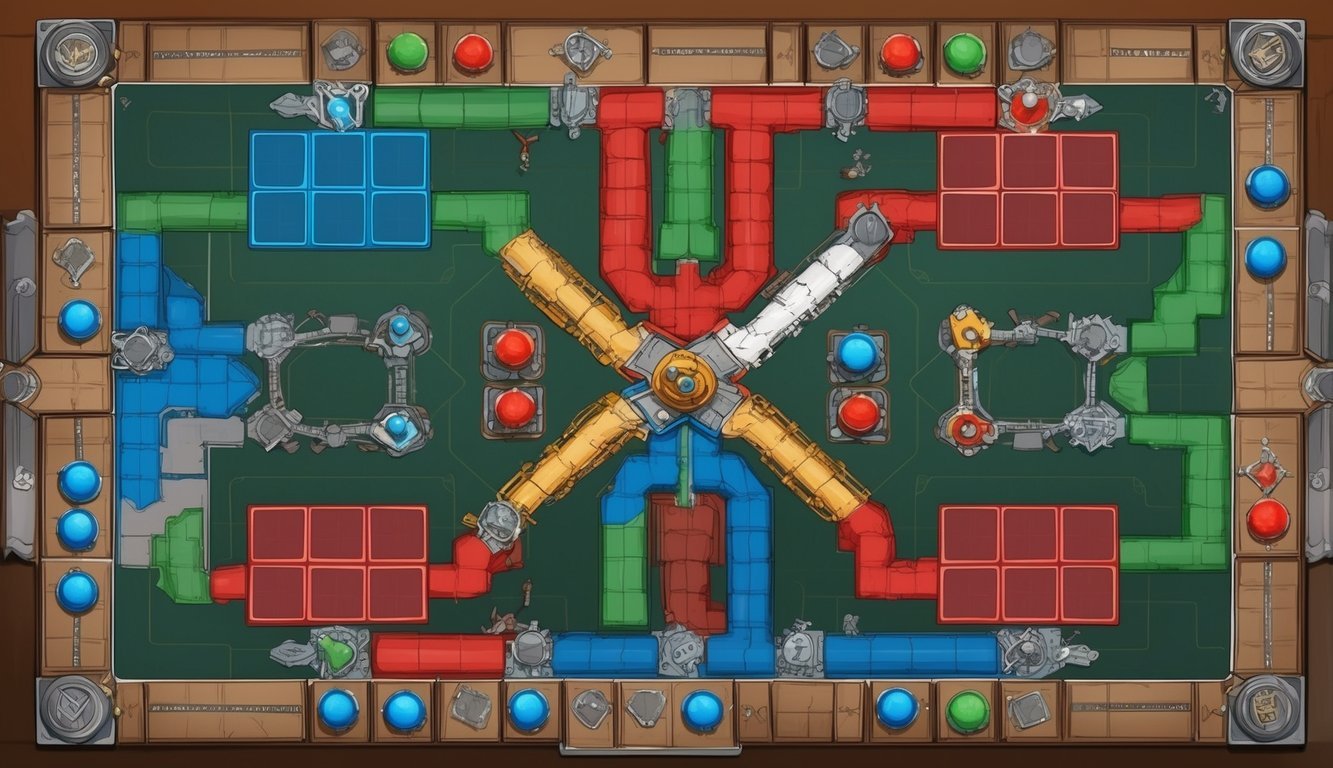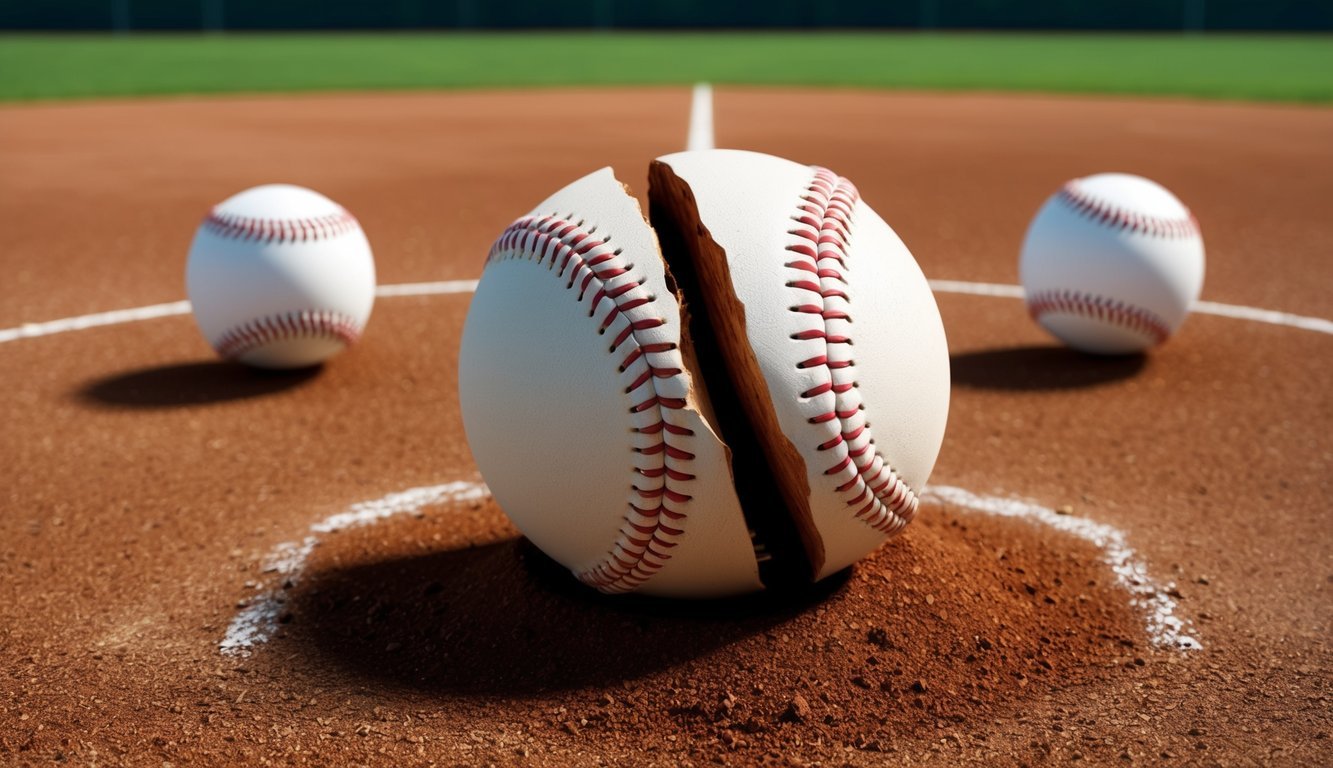The splitter pitch is a deceptive weapon in a baseball pitcher’s arsenal.
It starts like a fastball but drops sharply as it approaches home plate.
Batters often swing over the top of it, making the splitter an effective strikeout pitch.
Pitchers throw the splitter by gripping the ball with the index and middle fingers spread wide on either side of the ball’s seams. This grip reduces spin and causes the ball to tumble downward at the last moment.
Pitchers with long fingers and good flexibility tend to have more success with this pitch.
Many notable pitchers have used the splitter to great effect.
Roger Clemens and Curt Schilling were known for their devastating splitters, while modern pitchers like Masahiro Tanaka continue to fool hitters with this pitch.
The splitter’s sudden drop makes it a challenge for catchers too, adding an extra layer of excitement to the game.
Basics of the Splitter Pitch
The splitter pitch is a deceptive weapon in a pitcher’s arsenal.
It combines the appearance of a fastball with a sudden drop, fooling batters and inducing swings and misses.
Understanding the Pitch Mechanics
The splitter’s effectiveness lies in its unique flight path.
As it leaves the pitcher’s hand, it resembles a fastball in speed and trajectory.
However, the pitch suddenly drops as it approaches the plate.
This drop is caused by reduced backspin compared to a fastball.
The decreased spin creates less lift, causing the ball to “fall off the table” in baseball parlance.
Pitchers throw the splitter with similar arm speed to their fastball, making it hard for batters to distinguish between the two pitches until it’s too late.
Grip and Release Techniques
The grip is crucial for throwing a successful splitter.
Pitchers place their index and middle fingers on opposite sides of the ball, straddling the widest part of the seams.
This positioning allows for maximum spin control and movement as the ball is released.
Additionally, the thumb should provide stability underneath, ensuring the grip remains firm yet flexible.
Mastering the splitter can enhance a pitcher’s arsenal, but understanding how to throw a knuckleball requires a completely different technique focused on minimizing spin altogether.
This grip creates a ‘peace sign’ with the fingers spread apart.
The thumb rests underneath for support.
During release, pitchers apply pressure with their fingers, slightly “splitting” the ball.
This action reduces spin and creates the characteristic downward movement.
It’s important to maintain a consistent arm angle and motion with other pitches to avoid tipping off batters.
The Role of Finger Flexibility
Finger flexibility plays a significant role in throwing an effective splitter.
Pitchers need strong, flexible fingers to maintain proper grip and control throughout the throwing motion.
Exercises to improve finger strength and flexibility can enhance a pitcher’s ability to throw the splitter.
These might include squeezing stress balls or using finger stretchers.
Some pitchers naturally have longer fingers, which can be advantageous for throwing splitters.
However, with practice and proper technique, pitchers with average-length fingers can also master this pitch.
Finger flexibility also helps pitchers adjust their grip slightly to create variations in movement and velocity, keeping batters guessing.
Physical and Tactical Considerations
Throwing a splitter requires careful attention to physical mechanics and tactical decision-making.
Pitchers must balance effectiveness with potential risks to their arm health.
Arm Speed and Angle
Proper arm speed and angle are crucial for an effective splitter.
Pitchers should maintain their normal fastball arm speed to sell the pitch.
The arm angle should remain consistent with other pitches to avoid tipping off batters.
A slightly lower arm slot can enhance the downward movement of the splitter.
However, dramatic changes in arm angle may alert hitters to the incoming pitch.
Pitchers often experiment with different arm angles to find the optimal release point for their splitter.
This process involves trial and error during practice sessions.
Managing Pitcher’s Energy
Throwing splitters can be more taxing than traditional fastballs.
Pitchers need to carefully manage their energy throughout a game or season.
Some tactics for energy conservation include:
- Limiting splitter usage early in games
- Mixing in more fastballs between splitters
- Using the pitch strategically in high-leverage situations
Coaches often work with pitchers to develop a pitch count plan that incorporates splitters without overtaxing the arm.
Stress on the Elbow and Forearm
The splitter grip places unique stress on a pitcher’s elbow and forearm.
This increased strain can lead to fatigue or injury if not properly managed.
Common areas of concern include:
- Flexor-pronator mass in the forearm
- Ulnar collateral ligament (UCL) in the elbow
- Forearm muscles used to spread the fingers
Pitchers should incorporate specific strength and flexibility exercises targeting these areas.
Regular check-ins with trainers or medical staff can help monitor arm health.
Some pitchers find that limiting their splitter usage or adjusting their grip can reduce arm stress while maintaining pitch effectiveness.
Strategic Use in Games

The splitter pitch is a powerful tool when used strategically during baseball games.
It can disrupt batters’ timing, create off-balance swings, and set up other pitches effectively.
Deciding When to Throw a Splitter
Pitchers often use splitters in crucial moments to get key outs.
It’s especially effective with two strikes, as batters are more likely to chase pitches out of the zone.
Against power hitters, a well-executed splitter can induce weak contact or swings and misses.
Splitters work well when batters are expecting fastballs.
By mimicking fastball arm speed, the splitter’s late downward break catches hitters off guard.
It’s also useful when facing batters who struggle with low pitches or have trouble adjusting to changing speeds.
Some pitchers throw splitters more frequently in high-leverage situations, like with runners in scoring position or during late innings of close games.
Pitching to Disrupt Timing and Balance
The splitter’s effectiveness lies in its ability to upset a batter’s timing and balance at the plate.
As it approaches home plate, the pitch’s sudden drop often causes hitters to swing over the top or make weak contact.
To maximize disruption, pitchers should:
- Maintain consistent arm speed with fastballs
- Release the splitter from the same arm slot as other pitches
- Vary the count when throwing splitters to keep hitters guessing
The pitch’s movement can also throw off a batter’s balance, causing them to lunge or shift their weight too early.
This often results in ground balls or pop-ups, which are easier for the defense to field.
Creating Effective Pitch Sequences
Splitters become even more potent when incorporated into smart pitch sequences.
Mixing splitters with fastballs is a classic combination, as the two pitches look similar out of the hand but have very different outcomes.
Some effective sequences include:
- Fastball up in the zone, followed by a splitter down
- Back-to-back splitters at different depths
- Splitter after a series of fastballs to change the hitter’s eye level
Pitchers can also use splitters to set up breaking balls or changeups.
By keeping hitters off-balance with varied speeds and movements, pitchers create more opportunities for swings and misses or weak contact.
Comparing Splitters to Other Pitches

The splitter is a unique pitch that shares characteristics with both fastballs and off-speed pitches.
It can be a devastating weapon in a pitcher’s arsenal when used effectively.
Splitter Versus Fastball and Changeup
A splitter is thrown with fastball arm speed but has a significantly lower velocity.
It typically comes in 8-11 mph slower than a pitcher’s fastball.
This velocity difference is similar to a changeup, but the splitter has more downward movement.
Fastballs tend to maintain a straighter trajectory, while splitters drop sharply as they near the plate.
This sudden drop often leads to swings and misses or weak contact.
Changeups rely more on deception through arm speed and grip, while splitters use finger spread and forward rotation to create their movement.
Understanding Off-Speed and Breaking Pitches
The splitter falls into the off-speed pitch category along with changeups.
However, its sharp downward break also gives it breaking pitch qualities.
Unlike sliders or curveballs that have more lateral movement, splitters primarily drop vertically.
This makes them especially effective when paired with high fastballs.
Splitters are sometimes confused with forkballs, but forkballs are gripped deeper between the fingers and tend to have less velocity.
Sinkers share the downward movement of splitters but typically have higher velocity and less dramatic drop.
When executed well, splitters can be one of the most difficult pitches for batters to square up, often resulting in ground balls or strikeouts.
Notable Pitchers and Legendary Performances

The splitter has left an indelible mark on baseball history, with several pitchers utilizing it to achieve greatness.
From Hall of Fame careers to game-changing moments, this pitch has played a crucial role in shaping the sport.
Hall of Fame Splitters
Bruce Sutter pioneered the splitter in the 1970s, riding it to Cy Young success and a place in Cooperstown.
His mastery of the pitch opened doors for future generations.
Roger Clemens and Curt Schilling both incorporated devastating splitters into their arsenals, helping them rack up strikeouts and dominate hitters for years.
John Smoltz, another Hall of Famer, used the splitter as a key out pitch throughout his career.
These legends showcased how the splitter could be a game-changer when executed perfectly.
Memorable Game-Winning Splitters
In recent years, Masahiro Tanaka’s splitter helped him secure crucial wins for the Yankees in postseason play.
Shohei Ohtani has taken the pitch to new heights, generating an incredible swing-and-miss rate that often leaves batters looking foolish.
Kevin Gausman’s splitter has become one of the most effective pitches in the majors, helping him achieve All-Star status.
These pitchers have used the splitter to create unforgettable moments.
From strikeouts in tight situations to complete-game gems, fans will talk about them for years to come.
